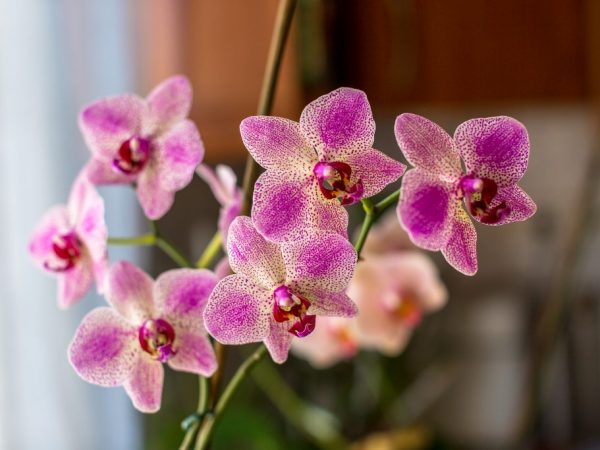Description of Spotted Orchid
Orchid representatives have always attracted flower growers with their flowering. The spotted orchid stands out from the rest of the varieties because of its dotted color throughout the flower. Thanks to this, the plant is in high demand in the flower shop.

Spotted orchid
Description of the variety
Spotted Orchid belongs to the Phalaenopsis variety, which grows in nature in the form of epiphytic herbaceous bushes. The variety is also called Mottled Moths because of its unusual color. The spotted orchid is considered one of the most unpretentious species of this flower. It has large fleshy leaves at the base. The root system is covered with a waxy layer and contains chlorophyll. When the root is saturated with moisture, it turns green.
The leaves of the speckled moths are dense and leathery. In a healthy plant, they are of a dark green shade with a waxy sheen. They are oblong-oval in shape. Small peduncles appear on them every six months, on which flowers are formed. Their size is about 8 cm in diameter. The shape of the flowers resembles a butterfly.
The purple orchid includes many color shades:
- cream;
- purple;
- yellow;
- white.
Its main difference from other varieties of phalaenopsis is an abundant number of small spots throughout the petal. An average plant grows up to 1 m.
Some representatives of the orchid begin to bloom only in the 2nd year. To determine how old the plant is, count the number of shoots. In an adult specimen, they are counted from 5 to 7 pieces. They release several peduncles a year - in spring and autumn.
Growing
Soil and the choice of container for planting
Spotted orchid does not grow in garden or forest soil. For her, choose a looser, lighter, moisture-permeable soil. You can buy ready-made soil for epiphytic plants in stores or prepare it yourself. To do this, grind into pieces about 2 cm:
- dense bark of fallen trees;
- charcoal
- Styrofoam;
- wine corks.
Then all the ingredients are mixed and cooked for 10 minutes. A little sphagnum moss is added to the cooled mixture. The pot should not be tightly filled with the substrate, so as not to harm the roots, and the plant could breathe. Chopped pine bark with a small amount of sphagnum is also chosen for the soil.
For the container, choose small plastic pots or glass vases with holes in the bottom and sides. This will help keep moisture out of the pot. And also use special epiphytic wicker bamboo or wooden baskets. In them, the roots develop calmly and freely. Ceramic containers are not advised to choose, they harm the root system and complicate the transplantation process.
Growing place
The spotted orchid loves warmth, but direct sunlight is harmful to it. A place near the eastern and southeastern windows, without drafts, is suitable for placing a flowerpot.
The flower is difficult to tolerate a change of location, therefore, it is not recommended to rearrange it from one place to another. Also, after winter, the plant weaned from bright sunlight, so it is shaded for a while.
Reproduction
Reproduction of orchids at home occurs using:
- dividing the flower - the plant is cut into 2 parts;
- cuttings - young shoots are cut into 20 cm;
- seeds - a complex type of reproduction that requires complete sterility;
- children - new roots and leaves that grow on shoots in different directions.
Care
After placing the plant in a permanent place in the house, the leaves get rid of dust deposits by wiping with a damp sponge every 7 days. To prevent the spotted hybrid phalaenopsis from wilting and blooming 2 times a year, the plants are given appropriate care.
| room | Agrotechnical event | Application |
| 1 | Watering | The flower is suitable for abundant, but rare watering. The pot is immersed in settled water, preferably without chlorine, for 40 minutes. The procedure is replaced by prolonged watering in the center of the pot. After that, the pot is returned to its place, and the next watering is performed after the soil has completely dried out. Water the plant in the morning. In hot weather - every 4 days, from September - once every 7 days, in winter - once every 14 days. |
| 2 | Temperature regime | They contain a flower in summer at temperatures from 24 to 30 ° C. To stimulate the formation of flower buds, the night temperature should be 5 to 6 ° C lower than the daytime. In winter, the temperature is kept in the range of 18-25 ° C. Due to low temperatures, the root system ceases to absorb moisture. A thermometer is placed near the pot to monitor the temperature. |
| 3 | Humidity | Tropical Spotted grows well at high levels of air humidity - 60-80%. The critical moisture indicator for a flower is below 30-40%. |
| 4 | Lighting | The spotted orchid variety loves good lighting. Additional lighting will be needed from autumn to spring. Flowers receive artificial light in the form of lamps and ultraviolet light. |
Water quality is an important element of irrigation. Use only settled, boiled or filtered, warm water. If it is possible to water with rainwater, then this is the best option for Phalaenopsis.

Spotted orchid care
Transfer
A houseplant is transplanted every 3 years, when the soil turns to dust. But there are exceptions if black spots appeared on the roots or the leaves began to fade, and the substrate became stony. Then a transplant is urgently needed.
I transplant the spotted orchid into another container with new soil. To do this, the plant is removed from the pot, the roots are slightly washed, the rotten ends are cut off and are too long.
Crushed activated or charcoal is poured onto the sections. Then he is left to rest overnight and put in a new convenient pot. Other reasons for transplanting are too small the volume of the planting capacity. This happens when roots begin to protrude from the pot, which displace the earth. Therefore, the plant should be transplanted into a large container.
Diseases
There are many diseases that the Spotted Orchid is susceptible to. Sources of disease: fungus, bacteria, viruses or parasite waste products. A common disease for orchids is rot. It can be of several types:
- sulfur rot;
- gray rot;
- root rot;
- brown bacterial rot.
The most common diseases of viral origin:
- anthracnose;
- leaf spot;
- powdery mildew.
It is impossible to fight these types of diseases. To combat rot of all types, pruning of diseased parts of the plant is used. Cut edges should be treated with a preparation containing copper or crushed coal. After that, the root is processed in preparations called Topsin or Fundazol. The root is placed in the solution 2-3 times every 10 days.
Pests
The main pests for orchids:
- spider, root mites;
- swampfly;
- scabbards;
- aphids;
- thrips.
The appearance of viral and fungal diseases is associated with inappropriate care and overflow of a flowerpot. Against thrips, whiteflies and scabies, solutions called Actellik or Fitoverm are used. The treatment is repeated 3 times every 8-10 days.The use of Fitoverm insecticide provides for the following proportions: 2 ml of substance per 50 ml of water.
To combat ticks, the roots are disinfected, for which a pale pink solution of potassium permanganate is used. For the prevention of diseases and pests, experts recommend the use of fertilizers with a normal concentration of nitrogen, which have the names: Greenworld, Cameleon and Oasis.
Conclusion
Spotted Orchid is an amazing plant with a rich spectrum of spotted petals. With proper care, it rarely gets sick and blooms 2 times a year.


